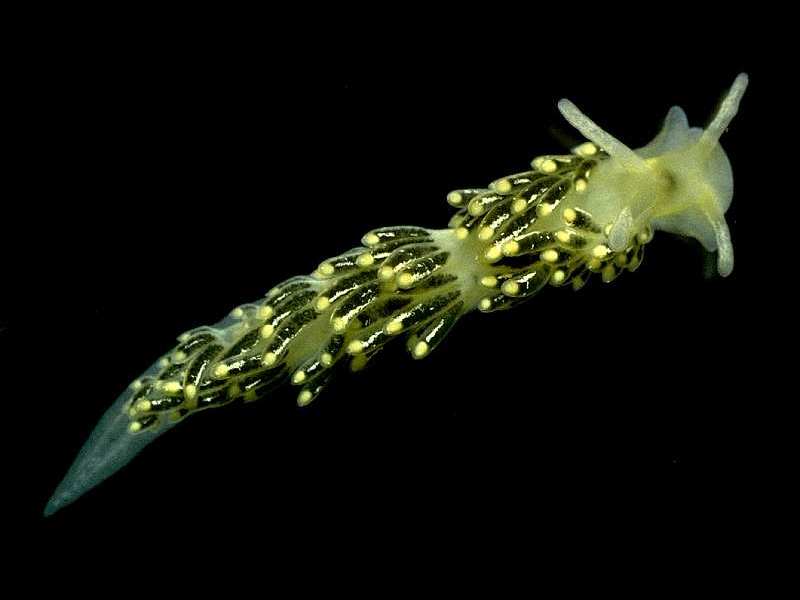| MOLLUSCA : Nudibranchia : Trinchesiidae | SNAILS, SLUGS, ETC. |
Diaphoreolis viridis (Forbes, 1840)
 |
| Diaphoreolis viridis |
Description: This aeolid is distinguished by its green ceratal contents and splashes of yellow-white pigment. The body is translucent white, often with a faint yellow hue. The cnidosacs at the tips of the cerata are large and conspicuous, off-white in colour. Streaks and spots of white pigment extend along the dorsal surfaces of the cerata. The brown jaws are clearly visible through the head in front of the rhinophores. Grows to about 15mm in length.
Habitat: Feeds on the hydroids Sertularella spp. especially Sertularella rugosa. Found in shallow exposed and semi-sheltered rocky areas.
Distribution: More common in the north of the British Isles, though records exist from the Atlantic coast of France. Specimens from Iceland may grow larger and develop more dense white pigmentation dorsally.
Similar Species: Trinchesia caerulea is similar in anatomy, both internally and externally, but easily distinguished by coloration.
Key Identification Features:
- Green ceratal contents.
- Yellow-white pigment on dorsal surfaces of cerata.
Distribution Map from NBN: Diaphoreolis viridis at National Biodiversity Network mapping facility, data for UK.
iNaturalist: Diaphoreolis viridis at iNaturalist World Species Observations database.
GBIF data for Tenellia viridis
WoRMS: Diaphoreolis viridis at World Register of Marine Species. Accepted name: Tenellia viridis (Forbes, 1840). AphiaID: 890636.
Classification: Biota; Animalia; Mollusca; Gastropoda; Heterobranchia; Euthyneura; Ringipleura; Nudipleura; Nudibranchia; Cladobranchia; Fionoidea; Trinchesiidae; Diaphoreolis
| Previous species | Next species |
| Picton, B.E. & Morrow, C.C. (2024). Diaphoreolis viridis. (Forbes, 1840). [In] Encyclopedia of Marine Life of Britain and Ireland. https://www2.habitas.org.uk/marbiop-ni/speciesaccounts.php?item=W14740. Accessed on 2025-04-16 |